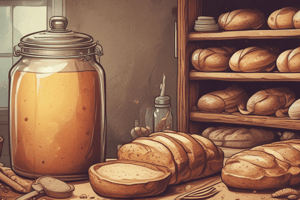Podcast
Questions and Answers
Yeast is a microscopic plant that undergoes fermentation by producing enzymes.
Yeast is a microscopic plant that undergoes fermentation by producing enzymes.
True (A)
Fermentation results in the production of carbon dioxide gas and sugar.
Fermentation results in the production of carbon dioxide gas and sugar.
False (B)
Diastatic malt helps yeast by breaking down starch into sugars.
Diastatic malt helps yeast by breaking down starch into sugars.
True (A)
The best fermentation temperature for yeast is between 60°F and 70°F.
The best fermentation temperature for yeast is between 60°F and 70°F.
Punching or folding dough during production is meant to expel carbon dioxide.
Punching or folding dough during production is meant to expel carbon dioxide.
Non-diastatic malt is primarily used to feed the yeast.
Non-diastatic malt is primarily used to feed the yeast.
Yeast begins to die at temperatures above 100°F.
Yeast begins to die at temperatures above 100°F.
Dough should be consumed within 24 hours to avoid spoilage without preservatives.
Dough should be consumed within 24 hours to avoid spoilage without preservatives.
Which type of sugar is known for its dry texture and is commonly served with coffee and tea?
Which type of sugar is known for its dry texture and is commonly served with coffee and tea?
Confectioners sugar is primarily used for baking and has a coarse texture.
Confectioners sugar is primarily used for baking and has a coarse texture.
What should you not do when storing cookies in an airtight container?
What should you not do when storing cookies in an airtight container?
Brown sugar should be stored in a(n) ______ container to prevent it from drying out.
Brown sugar should be stored in a(n) ______ container to prevent it from drying out.
Match the following cookie types with their descriptions:
Match the following cookie types with their descriptions:
Which liquid sweetener is known for its hygroscopic properties and provides moistness?
Which liquid sweetener is known for its hygroscopic properties and provides moistness?
What is the primary gas released by baking soda during chemical leavening?
What is the primary gas released by baking soda during chemical leavening?
Salt enhances the fermentation process by promoting yeast growth in baking.
Salt enhances the fermentation process by promoting yeast growth in baking.
Excess baking powder can cause a baked product to be too light and crumbly.
Excess baking powder can cause a baked product to be too light and crumbly.
Name one acid ingredient that can activate baking soda.
Name one acid ingredient that can activate baking soda.
List two functions of salt in baking.
List two functions of salt in baking.
Baking powders contain baking soda and one or more ________ to react with it.
Baking powders contain baking soda and one or more ________ to react with it.
What should products using single acting baking powder do immediately after mixing?
What should products using single acting baking powder do immediately after mixing?
Match the following leavening agents with their characteristics:
Match the following leavening agents with their characteristics:
What is the recommended storage condition for leavening agents?
What is the recommended storage condition for leavening agents?
What is the undesirable flavor created by baking ammonia?
What is the undesirable flavor created by baking ammonia?
What is the primary function of flour as a binder in baking?
What is the primary function of flour as a binder in baking?
Bran in flour improves gluten development.
Bran in flour improves gluten development.
What are the two proteins found in wheat flour that contribute to gluten formation?
What are the two proteins found in wheat flour that contribute to gluten formation?
The germ of the wheat kernel is high in __________, vitamins, minerals, and fat.
The germ of the wheat kernel is high in __________, vitamins, minerals, and fat.
Which type of wheat is primarily used to make cakes and pastries due to its lower protein content?
Which type of wheat is primarily used to make cakes and pastries due to its lower protein content?
Match the following ingredients to their effect on gluten development:
Match the following ingredients to their effect on gluten development:
What is the effect of temperature on gluten development?
What is the effect of temperature on gluten development?
Strong flours are made from hard wheats that contain greater quantities of gluten proteins.
Strong flours are made from hard wheats that contain greater quantities of gluten proteins.
Flashcards
Yeast Fermentation
Yeast Fermentation
The process where yeast converts simple sugars into carbon dioxide gas and alcohol.
Yeast Temperature Sensitivity
Yeast Temperature Sensitivity
Yeast activity is affected by temperature. It thrives in a specific temperature range.
Malt Syrup
Malt Syrup
A food source for yeast, adding flavor and crust color to baked goods like bread.
Diastatic Malt
Diastatic Malt
Signup and view all the flashcards
Yeast Dough Production - Step 1
Yeast Dough Production - Step 1
Signup and view all the flashcards
Yeast Dough Production - Step 3
Yeast Dough Production - Step 3
Signup and view all the flashcards
Yeast Dough Production - Step 10
Yeast Dough Production - Step 10
Signup and view all the flashcards
Yeast Dough Production - Step 9
Yeast Dough Production - Step 9
Signup and view all the flashcards
Flour's Role
Flour's Role
Signup and view all the flashcards
Wheat Kernel Parts
Wheat Kernel Parts
Signup and view all the flashcards
Hard vs. Soft Wheats
Hard vs. Soft Wheats
Signup and view all the flashcards
Gluten Formation
Gluten Formation
Signup and view all the flashcards
Controlling Gluten Development
Controlling Gluten Development
Signup and view all the flashcards
Salt's Role in Baking
Salt's Role in Baking
Signup and view all the flashcards
Bran's Impact on Gluten
Bran's Impact on Gluten
Signup and view all the flashcards
Dough Conditioners
Dough Conditioners
Signup and view all the flashcards
Chemical Leavening
Chemical Leavening
Signup and view all the flashcards
Baking Soda
Baking Soda
Signup and view all the flashcards
Baking Powder
Baking Powder
Signup and view all the flashcards
Single-Acting Baking Powder
Single-Acting Baking Powder
Signup and view all the flashcards
Double-Acting Baking Powder
Double-Acting Baking Powder
Signup and view all the flashcards
Baking Ammonia
Baking Ammonia
Signup and view all the flashcards
Leavening Agent Storage
Leavening Agent Storage
Signup and view all the flashcards
Muffins Mixing Method
Muffins Mixing Method
Signup and view all the flashcards
Salt's Role in Gluten
Salt's Role in Gluten
Signup and view all the flashcards
Salt's Impact on Yeast
Salt's Impact on Yeast
Signup and view all the flashcards
Why Brown Sugar Hardens
Why Brown Sugar Hardens
Signup and view all the flashcards
Demerara Sugar's Use
Demerara Sugar's Use
Signup and view all the flashcards
Confectioners' Sugar: Fine Powder
Confectioners' Sugar: Fine Powder
Signup and view all the flashcards
Cookie Baking Temperature
Cookie Baking Temperature
Signup and view all the flashcards
Double Sheeting for Cookies
Double Sheeting for Cookies
Signup and view all the flashcards
Storing Cookies: Separate & Airtight
Storing Cookies: Separate & Airtight
Signup and view all the flashcards
Study Notes
Yeast & Fermentation
- Yeast is a microscopic plant that accomplishes fermentation by producing enzymes.
- Some enzymes change complex sugars into simple sugars, and others change these simple sugars into carbon dioxide gas and alcohol.
- The chemical reaction is C6H12O6 + 2C02 → 2C2H5OH (simple sugar + carbon dioxide → alcohol).
- This process is called fermentation.
Yeast Temperature Sensitivity
- Yeast is a living organism sensitive to temperature.
- Inactive (storage temperature): 34°F (1°C)
- Slow action: 60°-70°F (15°-20°C)
- Best growth (fermentation and proofing temperatures for bread doughs): 70°-90°F (20°-32°C)
- Reaction slows: Above 100°F (38°C)
- Yeast is killed: 140°F (60°C)
Malt Syrup
- Malt syrup (or malt extract) provides food for yeast and enhances flavour and crust colour in baked goods.
- Extracted from barley.
- Diastatic: Breaks down starch in dough into sugars that yeast feed on. May cause a sticky crumb.
- Non-diastatic: Added as a sweetener.
Yeast Dough Production Steps
- Scaling Ingredients: Accurately measuring ingredients.
- Mixing: Combining ingredients, distributing yeast, developing gluten.
- Fermentation: Yeast produces carbon dioxide (CO2).
- Punching/Folding: Releases CO2 and relaxes gluten.
- Scaling: Dividing dough into equal portions.
- Rounding: Shaping dough for easier handling.
- Benching: Resting dough to allow gluten to relax.
- Makeup & Panning: Shaping dough and placing it in baking pans.
- Proofing: Continuing fermentation, proofing typically involves keeping the dough at a moderate temperature where the yeast continues to rise and produce more gas.
- Baking: Oven spring, coagulation of proteins, gelatinization of starches, browning.
- Cooling: Removing excess moisture & alcohol.
- Storing: Consume within 8 hours (without preservatives).
Studying That Suits You
Use AI to generate personalized quizzes and flashcards to suit your learning preferences.




